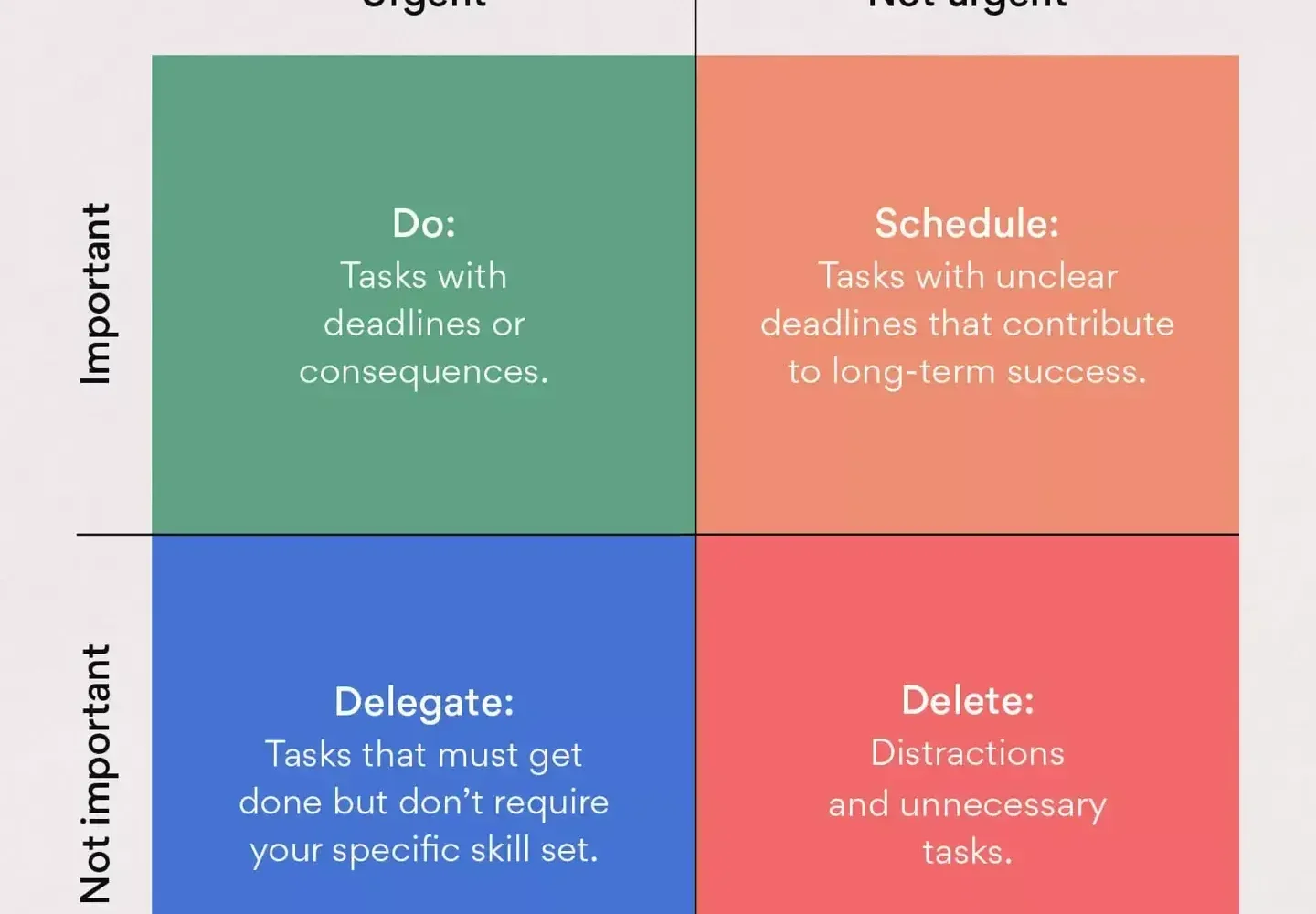In my early days as a solopreneur, I often drowned in an endless list of tasks (more often than I’d like.) Every item on my to-do list felt urgent, and I was constantly pulled in different directions.

Yet, by the end of each day, I felt like the most critical stuff remained unattended. To put it lightly, I was frustrated with this pattern.

Desperate for a solution, I stumbled across the Eisenhower Matrix, which teaches prioritizing like a president. Once I adopted it, things started changing. Using the Eisenhower Matrix in my day-to-day task planning didn’t just help me get more organized: it transformed my decision-making process.
Over time, prioritizing like a pro has become second nature. I’ve been using the matrix for every decision I make — from making marketing plans and prioritizing my finances to chalking out and working toward my long-term goals.
To help you put chaos behind you as I did, grab this free Eisenhower Matrix template and get started right away. If you want to understand how it all works, I’ve compiled a detailed guide on using the Eisenhower Matrix for better prioritization and decision-making.
Table of Contents
- What is the Eisenhower Matrix?
- The Benefits of Using an Eisenhower Matrix
- How to Use an Eisenhower Matrix
- The Eisenhower Matrix Template
- Eisenhower Matrix Examples for Marketers
- Tips for Making an Eisenhower Matrix
Read along to learn how to keep your projects (and sanity) on track.
The Eisenhower Matrix, also known as the Urgent-Important Matrix, is a simple yet powerful decision-making tool. It’s a framework to categorize tasks into four quadrants based on urgency and importance.
The matrix was named after Dwight D. Eisenhower, the 34th U.S. President who inspired it. In a 1954 speech quoting an unknown university, Dwight famously said, “I have two kinds of problems, the urgent and the important. The urgent are not important, and the important are never urgent.”
These words encouraged Stephen Covey, the author of “The 7 Habits of Highly Effective People,” to channel those words to develop what is now popularly known as the Eisenhower Matrix.

Source
Let’s look into what these four quadrants are all about.
Understanding the 4 Quadrants of the Eisenhower Matrix
Quadrant 1: Urgent & Important
This quadrant is the “do” one, where tasks to be done immediately should be placed. Here, you should add all the important, urgent, and high-priority tasks on your to-do list (and mind).
Example: Renew your business license before the lurking renewal date.
While filtering to add a task (or not) to this quadrant, some questions you can ask yourself include:
- Should this be done right now, or can it be deferred?
- Does avoiding this task have negative consequences or affect my long-term goals?
- Will this task continue stressing me out till I complete it?
Quadrant 2: Important, Not Urgent
This quadrant is the “schedule” one. It should feature tasks that are not precisely urgent priority yet are essential for your long-term goals. These are the ones you want to address after tackling the quadrant one tasks that need to be done immediately.
Example: Building your content strategy.
Quadrant 3: Urgent, Not Important
This is the “delegate” quadrant. It must capture those tasks that you can classify as urgent but not important. Here, you can place in to-dos that need to be completed immediately but don’t impact your long-term goals.
Example: Water the plants in your office.
It’s best to delegate these to your team members since their completion doesn’t rely on your specific skill set to complete, and delegation helps you better manage your workload.
Quadrant 4: Neither Urgent nor Important
This is the “eliminate” quadrant, where you can add the unimportant or non-urgent tasks left over after filling up your first three quadrants. These tasks are more like distractions and get in the way of you accomplishing your goals.
Example: Doom-scrolling social media or checking your email every fifteen minutes.
But wait, why use this matrix and classify tasks into quadrants?
The Benefits of Using an Eisenhower Matrix
Since I’ve been using the Eisenhower Matrix, I’ve found myself prioritizing and managing my time better instead of spinning the wheels on low-value activities and panicking later. I’ve witnessed the following benefits of using the Eisenhower Matrix to plan.
1. Reducing decision fatigue.
According to research published by Harvard Business Review, the average adult makes 33,000 to 35,000 total decisions each day (yeah).
Imagine throwing weighty decisions into this mix, which we all must make in the daily grind of work. Everything gets overwhelming when it feels like a priority, right?
Decision fatigue pops in, precisely what the Eisenhower Matrix helps to counter.
Using the matrix, I’ve learned firsthand how to eliminate the guesswork in my plans and precisely define what deserves my attention first. This has saved me so much effort and mental fatigue.
Better still, I’ve been able to focus my quality time on decisions that matter most.
2. Ensuring long-term goals don’t fall through the cracks.
The second quadrant of Eisenhower’s matrix has helped me make a real change.
Systematically pursuing the items in the schedule quadrant has helped me ensure I don’t slack on dedicating time to strategic initiatives. With direction clarity from using the matrix, I now make it a point to spend time on tasks like developing my marketing strategy.
This has ensured I don’t sway from my goals, as 92% of people do statistically. In essence, it has driven actual results over time.
3. Saving time.
The Eisenhower Matrix has been a game-changer for saving time and helping me make the most of every hour. And time is money, right?
Highlighting low-priority tasks in Quadrants 3 and 4 has allowed me to quickly cut out the loose strings that had been delaying my productivity for years. With mental clarity, I now delegate what I must right at the onset and scratch out spending time on tasks I’d rather avoid.
Inspired by these benefits? In addition to using the Eisenhower Matrix, you can also use these Skill Development Templates to improve your skills and performance.
How to Use an Eisenhower Matrix
Using the Eisenhower Matrix is quite simple. Here’s how I worked through the process and how you can, too.
1. List all your tasks.
Start by brain-dumping. At this stage, I list everything I need to do without worrying about organizing anything, and that’s what you should do!
Pro tip: Listing everything can lead to an endless spiral of overthinking and wasted time. To focus better, use a timer to limit this step to 15 minutes.
2. Categorize each task.
Next, review your list and allocate tasks to the four quadrants. Here’s my thumb rule to classify tasks quickly:
- Quadrant 1. Deadlines or emergencies.
- Quadrant 2. Planning, relationship building, or strategy.
- Quadrant 3. Quick-turnaround requests or tasks that I can delegate.
- Quadrant 4. Activities that don’t add value.
Pro tip: Limit tasks to a maximum of ten per quadrant to avoid cluttering your matrix and leaving yourself overwhelmed. Remember, you can always create different matrices for professional and personal use, so there is no need to cram everything into one.
3. Act based on priority.
This is the final step to get the ball rolling and start acting on your to-dos.
When implementing, ensure you tackle Quadrant 1 tasks first; schedule time for Quadrant 2. Meanwhile, delegate Quadrant 3 tasks to use your time best. Lastly, remove the time-sucking activities in Quadrant 4 from your radar.
Pro tip: Start blocking time on your calendar for Quadrant 2 tasks. When you treat these appointments with the same importance as meetings, you’ll see how you’ll move closer to your long-term goals.
The Eisenhower Matrix Template
Would you like a head start on using the Eisenhower Matrix? I’ve found the simplest way to get started is to use a (free!) customizable Eisenhower Matrix template. It’s available as a Google Sheet and a downloadable spreadsheet.

Source
To use the template, simply fill in the four quadrants with your tasks, accounting for their urgency and importance levels. As an example, I’ve filled out one task for each quadrant.
- Urgent & Important: I’ve entered a task that needs immediate attention. My blog has a deadline of tomorrow, so it’s both urgent and essential.

- Important, Not Urgent: Here, I’ve added a project that’s strategically valuable to me. While building a content plan is definitely essential, it’s not urgent. I wouldn’t be in trouble if I took it up a few days later. So, Quadrant 2 it is!

- Urgent, Not Important: Here, I’ve added a task that I’d prefer the team to help me with. Scheduling blogs on the CMS goes in here, as it doesn’t rely on my specific skillset. I could use help to save time for more critical activities.

- Neither Urgent nor Important: I’ve filled this quadrant with a reminder of what not to do. Yep, endlessly surfing through my competitor’s social media and getting lost in that ocean is something I’d rather avoid.

Eisenhower Matrix Examples for Marketers
You may wonder if the Eisenhower Matrix is for everybody. I mean, does it make sense for those who are not in decision-making roles? I’d say yes. And if you’re wondering specifically if it makes sense for marketers, my verdict is: it’s incredibly practical.
I’ve compiled some examples of how it applies to marketing. These should give you a direction on where to focus and where to avoid distractions in the marketing world.
Example 1: Using the Eisenhower Matrix in Content Marketing
- Quadrant 1: Finalize a blog post due to be published today.
- Quadrant 2: Create a six-month editorial calendar, conduct a content audit, or research trending keywords for SEO.
- Quadrant 3: Respond to non-urgent media inquiries.
- Quadrant 4: Tweak visuals on a low-performing blog post.
Example 2: Using the Eisenhower Matrix in Campaign Management
- Quadrant 1: Fix a broken link in a live email campaign.
- Quadrant 2: Analyze performance metrics to optimize future campaigns.
- Quadrant 3: Review vendor proposals.
- Quadrant 4: Scroll through competitor’s social media feeds without a specific goal.
Example 3: Using the Eisenhower Matrix in Social Media Management
- Quadrant 1: Respond to the viral customer complaint.
- Quadrant 2: Build a social media calendar for the next quarter.
- Quadrant 3: Delegate graphic creation for routine posts.
- Quadrant 4: Discuss social posts at length with the team without clear ROI.
Tips for Making an Eisenhower Matrix
Working with an Eisenhower Matrix over all these years, I’ve learned a few things that I now treat as thumb rules. Here are my top tips.
1. Start small.
In the beginning, the matrix can feel overwhelming if there are too many tasks — at least, that’s what happened to me. So, I figured it would be easier to start applying it to just one project or a week’s worth of tasks. Once comfortable, expanding is always easy.
2. Audit your tasks regularly.
Priorities shift, so it’s best to revisit my Eisenhower Matrix weekly. This ensures my to-dos are always relevant and keep up with the dynamism around me.
So, schedule regular audits and ensure your matrix is always a work in progress.
3. Be honest about what’s “important.”
Over the years, I’ve realized how easy it is to mistake urgency for importance. So now, to avoid that, before assigning tasks, I always ask myself, “What happens if I do this later?” or “Does this align with my goals?” I’ve seen how this simple exercise helps me compartmentalize better, and you should do the same!
4. Communicate priorities.
When I delegate tasks from Quadrant 3 these days, I make it a point to clarify why they matter. I’ve seen firsthand how explaining the bigger picture to the assignee impacts the outcome. So, don’t be shy about communicating priorities when you put someone on the task.
Ready to prioritize?
Eisenhower Matrix offers a valuable lesson that productivity isn’t about doing more but about doing what matters.
Using this framework has been game-changing for me. It’s helped me reclaim my time, reduce stress, and progress toward my goals. I recommend using the Eisenhower Matrix to improve your prioritization and decision-making skills.
On that note, happy prioritizing — like a president.
![How the Eisenhower Matrix Can Keep Your Projects on Track [My Experience]](http://blog.contentkrush.com/wp-content/uploads/2021/06/cropped-ck1.png)

![How the Eisenhower Matrix Can Keep Your Projects on Track [My Experience] How the Eisenhower Matrix Can Keep Your Projects on Track [My Experience]](https://accesspressthemes.com/import/vmagazine/wp-content/uploads/2018/05/u7-adss.jpg)






![How to Write a Creative Brief in 11 Simple Steps [Examples + Templates] how-to-write-a-creative-brief-in-11-simple-steps-[examples-+-templates]](https://blog.contentkrush.com/wp-content/uploads/2025/02/140921-how-to-write-a-creative-brief-in-11-simple-steps-examples-templates-510x369.webp)
![Getting Your Scope of Work Right — the Complete Guide [+ Templates & Examples] getting-your-scope-of-work-right-—-the-complete-guide-[+-templates-&-examples]](https://blog.contentkrush.com/wp-content/uploads/2024/11/140557-getting-your-scope-of-work-right-the-complete-guide-templates-examples-510x369.jpg)









Comment here